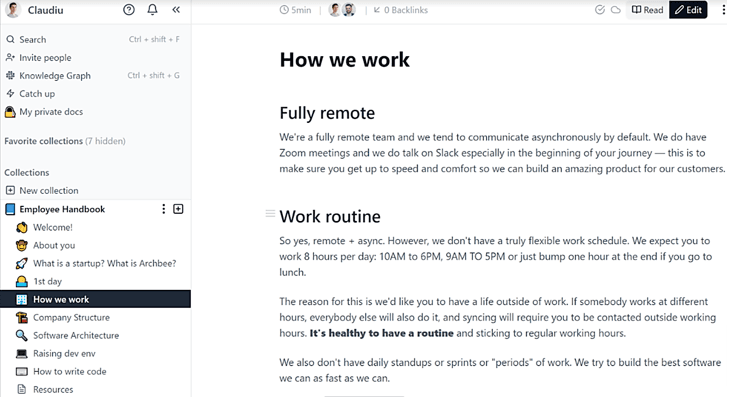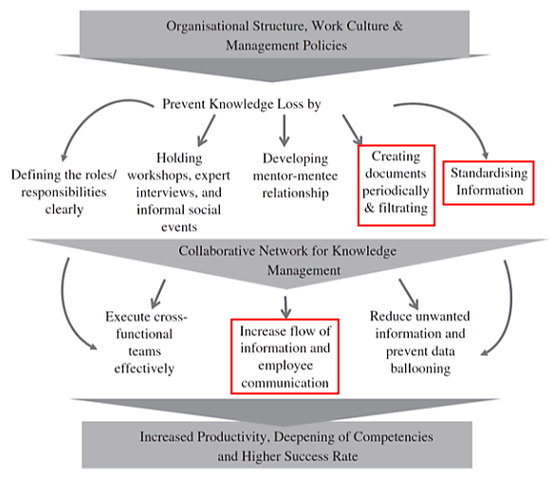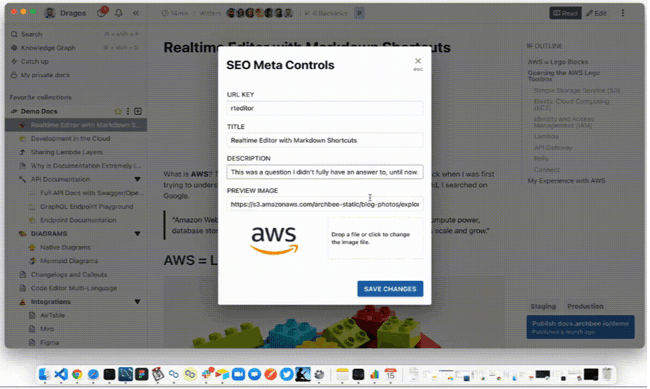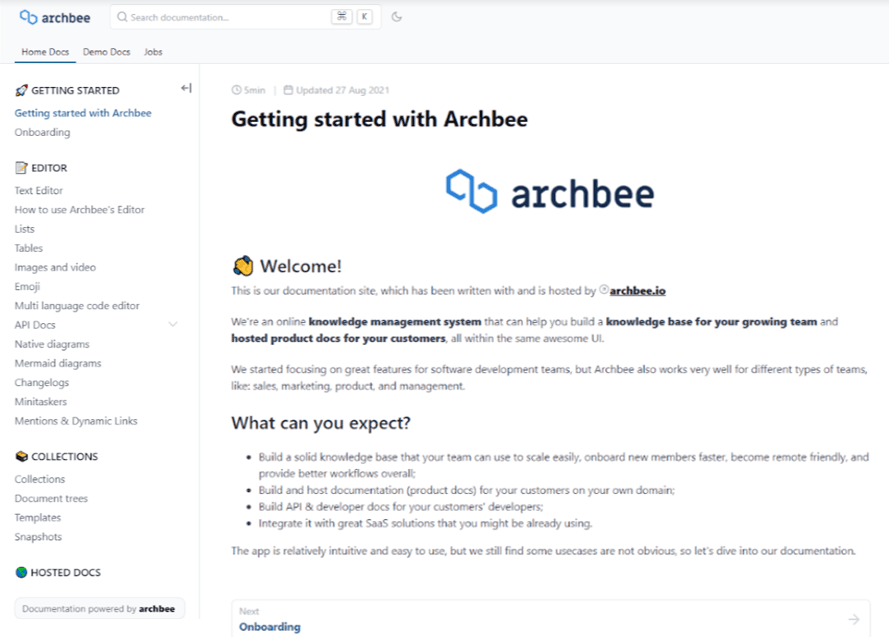Today, having great SaaS documentation is synonymous with having a great SaaS product.
In other words, documentation is a key element that ties all the features of your product together, provides support to both your employees and customers, helps attract and educate new users and retain existing ones.
As such, it can give SaaS companies a competitive advantage they can use in their marketing and sales strategies to help them grow their business.
In this article, we’ll take a closer look at five reasons why having great documentation is critical for the success and sustainability of SaaS companies.
Providing a Single Source of Truth for Employees
We’ll start with the fact that great SaaS documentation means key information available to all employees in one place, which helps them do their job with more competence and independence.
Simply put, when your employees can find all the relevant guides, tutorials, user manuals, release notes, and other information about your SaaS product in one easily accessible place, they’re provided with a single source of truth they can always turn to.
More specifically, your employees can access and search centralized SaaS documentation to find guidance and support for their work, make informed decisions, and improve their performance and productivity.
Of course, this is especially useful for onboarding new employees, as they can quickly get up to speed with the company’s policies and work procedures and learn about the SaaS product.

Source: Archbee
In addition to new hires, user-friendly SaaS documentation can also be used by your current employees.
For example, quality assurance, customer support, and marketing and sales staff can learn about the latest SaaS product features and updates and review relevant instructions, guides, and documents.
Therefore, they will need much less support from the product manager, developers, and designers when doing their job, making them feel more competent and self-sufficient.
At the same time, SaaS companies can use the centralized documentation database to prevent knowledge loss if key employees leave.
In fact, as you can see highlighted below, documentation management and information flow are crucial elements in the general framework for minimizing the internal loss of knowledge within companies.

Source: Research Gate
For SaaS companies, retaining internal knowledge starts with having a central knowledge base in which the company’s critical product information, workflows, and procedures are documented, regularly updated, and made available to all team members.
This significantly lowers the risk of disruptions in the event of employee turnover.
Finally, SaaS companies can use their SaaS documentation to facilitate knowledge sharing and provide product knowledge training to all employees.
Knowledge can be shared by providing easy access to training materials and resources, such as guides, tutorials, training videos, etc., based on well-organized and comprehensive SaaS product documentation.
Overall, having great documentation implies that all employees can find all the relevant information in one place, which enables SaaS companies to empower their employees, easily onboard new hires, prevent knowledge loss, and provide training to all employees.
Attracting More Users to Your SaaS
When it comes to users of your SaaS product, having well-structured documentation optimized for search engines increases the online visibility of your product, which helps you attract more users.
In other words, your SaaS documentation, published on a documentation website, should be rich in SEO-friendly, well-written, and informative content that helps existing and potential users answer their questions or solve their problems.
So, when potential users have a specific product-related question or issue to deal with, it is much more likely that Google (and other search engines) will rank your documents high enough so they can easily find what they’re looking for, like in this example.

Source: Google
This increases user satisfaction with your product, which can help generate positive word-of-mouth marketing.
Such recommendations (offline and online) are one of the most powerful marketing tools for attracting new customers in any industry.
As for people looking for an answer not directly related to your product, they can still discover your documentation site as a source of well-formulated and helpful information about their query.
Naturally, this can spark their interest in your SaaS product, making them potential new customers.
So, how can you create and publish engaging and informative documentation optimized for search engines?
You can use a documentation platform like Archbee to create high-quality, SEO-friendly documentation.

Source: Archbee
As you can see, you can control the SEO meta-attributes of every document you want published to improve its ranking on search engines.
But even before you get there, Archbee will provide a user-friendly editor to help your team create a well-structured, hierarchical organization of your documentation that search engine bots can easily crawl and index.
This will lead to higher online discoverability of your SaaS documentation, increasing user satisfaction and reaching potential new customers.
Therefore, ensuring your SaaS documentation is informative, helpful, and SEO-friendly is a crucial step in attracting more users to your product.
Educating New Customers on the Product
As we mentioned, prospective users who discover your SaaS product through its documentation and find it interesting will want to learn more about it, and your documentation can be used to educate them on the product and entice them to purchase it.
Likewise, when new customers opt for your SaaS product, you can easily onboard them through self-service onboarding.
In other words, great SaaS documentation can provide new customers with all the information they need to start adopting your product successfully.
Documentation can be used to guide, educate, and train new users in the form of step-by-step guides, video tutorials, instructions, and user manuals, all available on your website.

Source: Archbee
Such getting-started guides educate new users on how they can use different product features and what benefits they can derive, which improves the initial product adoption rate and helps retain users later on.
Furthermore, all these resources enable customers to get to know the product and start using it without needing live customer support (messages, emails, phone calls).
Therefore, by providing their documentation in a user-friendly format available on an easy-to-navigate documentation website, SaaS companies reduce the time and resources needed to onboard new customers.
As you can see, SaaS companies can use documentation to help new customers understand the product, as well as educate them on how to start using it through self-service onboarding.
Keeping Existing Customers in the Loop
Moving on from new to existing customers, keeping users in the loop is another essential element of great SaaS documentation that can help increase customer retention and reduce customer churn.
This works on two levels.
First, even though customers may have been using your SaaS product for a while, they may not be familiar with all its features and capabilities, which means they’re not getting the most value out of it.
Therefore, when existing users can easily find use cases, tutorials, and how-to guides for more advanced product features in your SaaS documentation, that demonstrates the value of your product and helps turn them into power users who take full advantage of all product features.
You can learn more about why power users are important for SaaS companies and how to get more of them in an article by Userpilot.

Source: Userpilot
The second level of utilizing SaaS documentation to keep existing customers in the loop focuses on informing them about all product updates and changes, including new features, bug fixes, and performance improvements.
This information, usually published in the form of release notes or change logs, helps reduce confusion or frustration caused by, for example, unexpectedly running the latest update or unsuccessfully trying out a new product feature.
At the same time, it shows that the SaaS company is committed to continually improving its product, delivering more value, and providing timely customer support.
To put it in a nutshell, SaaS companies can increase customer retention and minimize customer churn by keeping existing customers informed about product features and updates through SaaS documentation, helping them get the most value out of the product.
Providing On-Demand Customer Support
As it’s clear from the previous sections, great SaaS documentation provides customers with ongoing, on-demand customer support, which can save both them and your company a lot of time and effort.
In other words, whenever a customer has a question or a problem, comprehensive SaaS documentation will provide them with an answer or a solution.
This means they don’t have to immediately contact customer support, and the support team will receive fewer support tickets.
Therefore, SaaS documentation (installation guides, feature tutorials, FAQs, troubleshooting section, etc.) helps users resolve a range of simpler issues by themselves (self-service), freeing the support team’s time and resources to focus on more demanding support requests.
Of course, all this information should be clearly displayed in the product’s interface, or on your company website and social media, usually in the form of a help center.

Source: Zapier
In fact, a good product knowledge database can provide SaaS users with practically all the customer support they need to use your product correctly and efficiently.
Furthermore, customers can receive even more human-like support when SaaS documentation is combined with a chatbot programmed to answer common questions and provide links to relevant resources.
Naturally, this enables SaaS companies to further reduce the number of support tickets and lighten the workload of their customer support agents.
Finally, ongoing customer support should always include improvements, whether of the product itself or its documentation, that are based on the analysis of support tickets and customer feedback.
Overall, well-organized SaaS documentation provides on-demand customer support by utilizing various methods that enable customers to find answers to their questions, which saves them time and enhances their user experience.
At the same time, great documentation minimizes the number of support requests and enables your customer support team to improve their service, thus increasing customer satisfaction.
Conclusion
To summarize, when your employees are concerned, the importance of having well-structured, well-written and well-designed SaaS documentation is reflected in the fact that it increases their efficiency by providing a single source of truth they can rely on.
As for your customers, such documentation enables your company to attract more users, educate new customers, keep existing ones in the loop, and provide on-demand customer support.
In this day and age, these competitive advantages can be crucial for your SaaS company's continued success and sustainability.
Archbee is a unified solution for technical documentation. Explore its full range of features with our free 14-day trial.
Frequently Asked Questions
Because it compounds value across your entire business.
- Aligns teams: A single source of truth keeps product, engineering, sales, and support on the same page.
- Speeds onboarding and decisions: Clear, searchable guidance helps people ramp faster and make confident calls without bottlenecks.
- Preserves knowledge: Processes, workflows, and product details stay with the company when people move roles or leave.
- Attracts new users: SEO-friendly docs rank for real questions, bringing in qualified, high-intent traffic.
- Boosts activation and adoption: Practical how-tos and use cases help customers find value quickly and explore advanced features.
- Reduces churn: Release notes and change logs keep users informed about updates, fixes, and improvements.
- Scales support: Self-serve answers deflect tickets and shorten resolution times.
Bottom line: great documentation turns questions into momentum and creates a durable competitive advantage.
